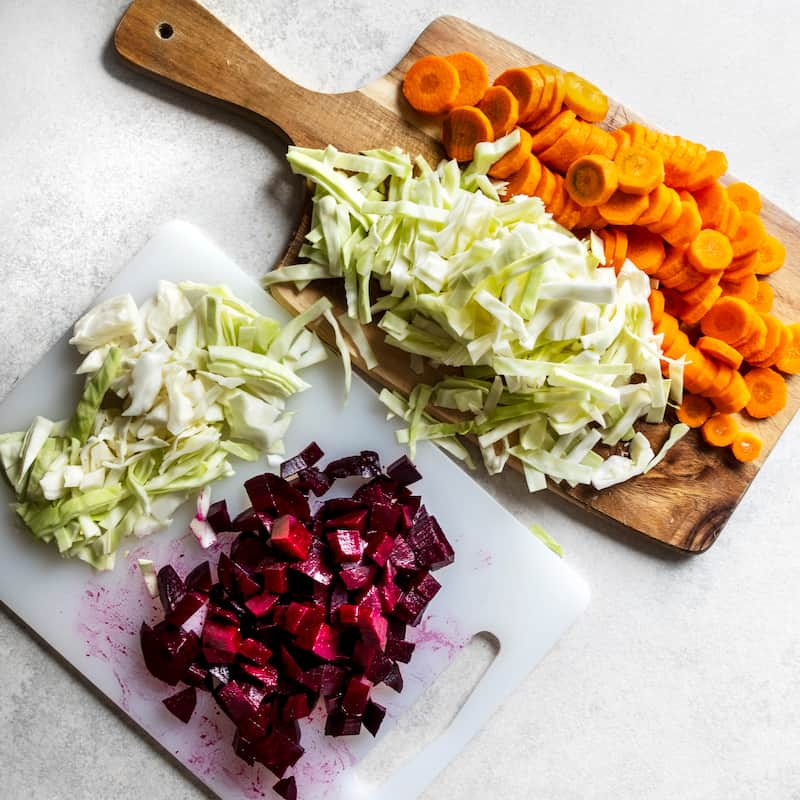Barszcz Ukraiński z Fasolą
Barszcz Ukraiński: Barszcz with White Beans (aka “the Ukrainian Borscht”)
How to pronounce it?
barshch ookrai-insky
‘Play’ to hear:
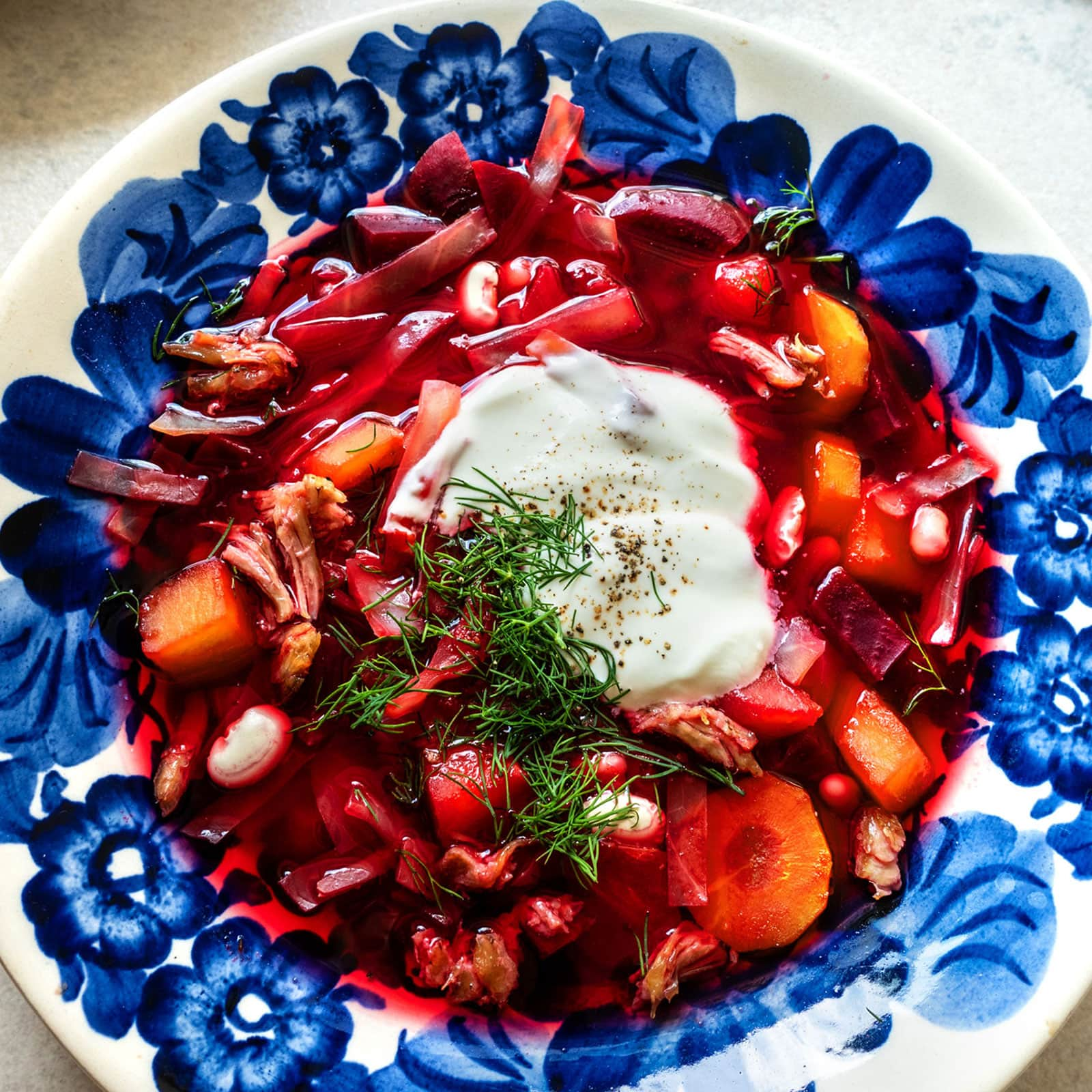
While I personally avoid using the term ‘Borscht,’ it seems to be the most commonly searched name for this soup. I hope that with time, the actual Polish spelling will gain greater recognition and become more universally embraced.
There are a lot of ways to up the cosiness factor of a bowl of red borscht, but my favourite is to add a generous amount of white beans. And that’s where this classic recipe comes in:
Barszcz Ukraiński (meaning: ‘Borscht à la Ukraine’, ‘Ukrainian Borscht’) is a soup brewed on red beetroots; and jam-packed with white beans.
This homemade dish is pure comfort, with a brothy pork-rib base that’s filled with cabbage, carrots, and diced potatoes. Served with a dollop of sour cream and freshly chopped dill, it will make your day.
For the full list of ingredients & detailed instructions, please see the recipe card at the end of this post. But before you scroll, there’s important stuff to know below.
In the Eastern Borderlands (in Polish: ‘Kresy’), as the cultures permeate one another, many Ukrainian recipes slowly became Polish classics.
This Polish variant of the Ukrainian borscht differs from the original. The recipe has been modified by us and has a few additions – most notably white beans and occasionally, wild dried mushrooms as well.
In Ukraine, Borscht with white beans is known as ‘Chernihiv Borscht’ (in Ukrainian: борщ чернігівський, borszcz czernihiwśkyj) [source in Ukrainian]
Do you need any special ingredients or equipment to make this ‘Barszcz Ukraiński’?
Most of the ingredients should be available in any larger supermarket.
Internationally, you may have some trouble getting celery and parsley roots. They’re common vegetables here in Poland, used in almost every soup recipe. If you can’t find them anywhere, try using parsnips, turnips, or extra onions.
We’re cooking this soup on pork ribs – but feel free to use a ham hock, diced veal or poultry thighs (chicken, turkey, duck, goose) instead.
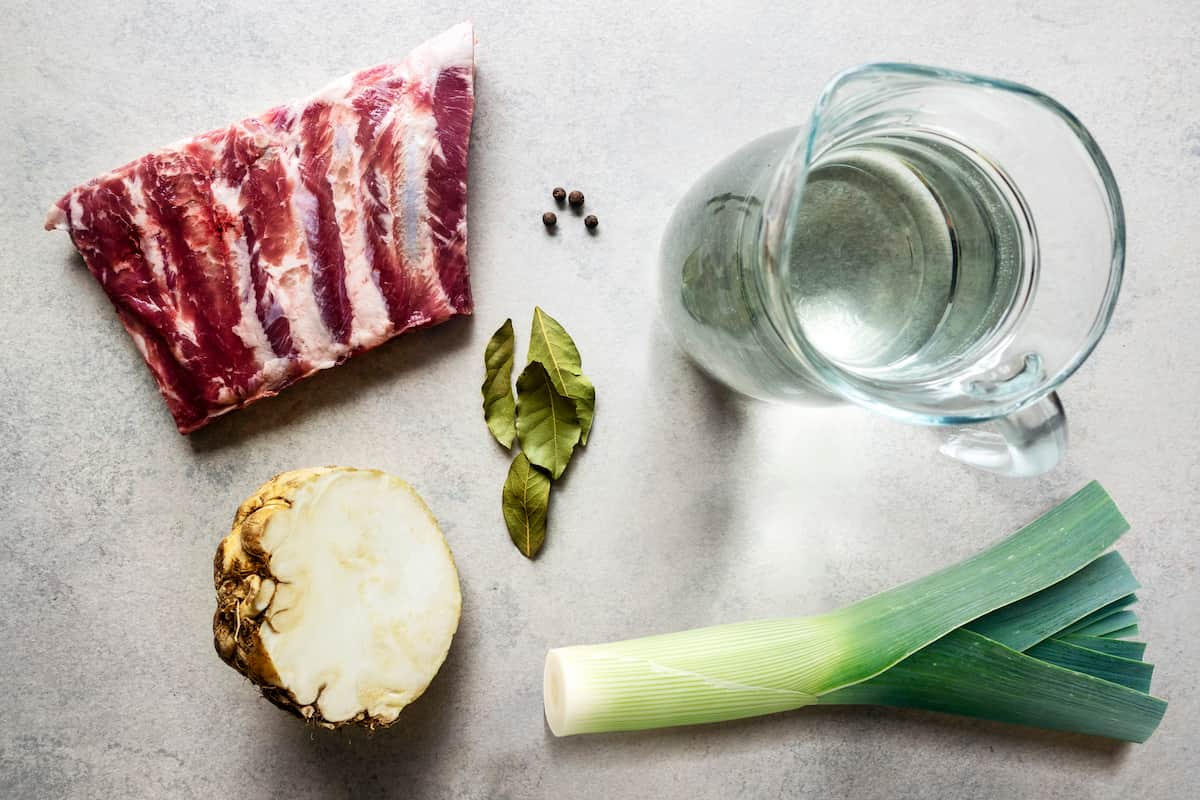
You’ll also need half a can of cannellini (white kidney) or lima beans, pre-soaked and cooked. You could use dry beans instead, but you’ll need to soak them the night before.
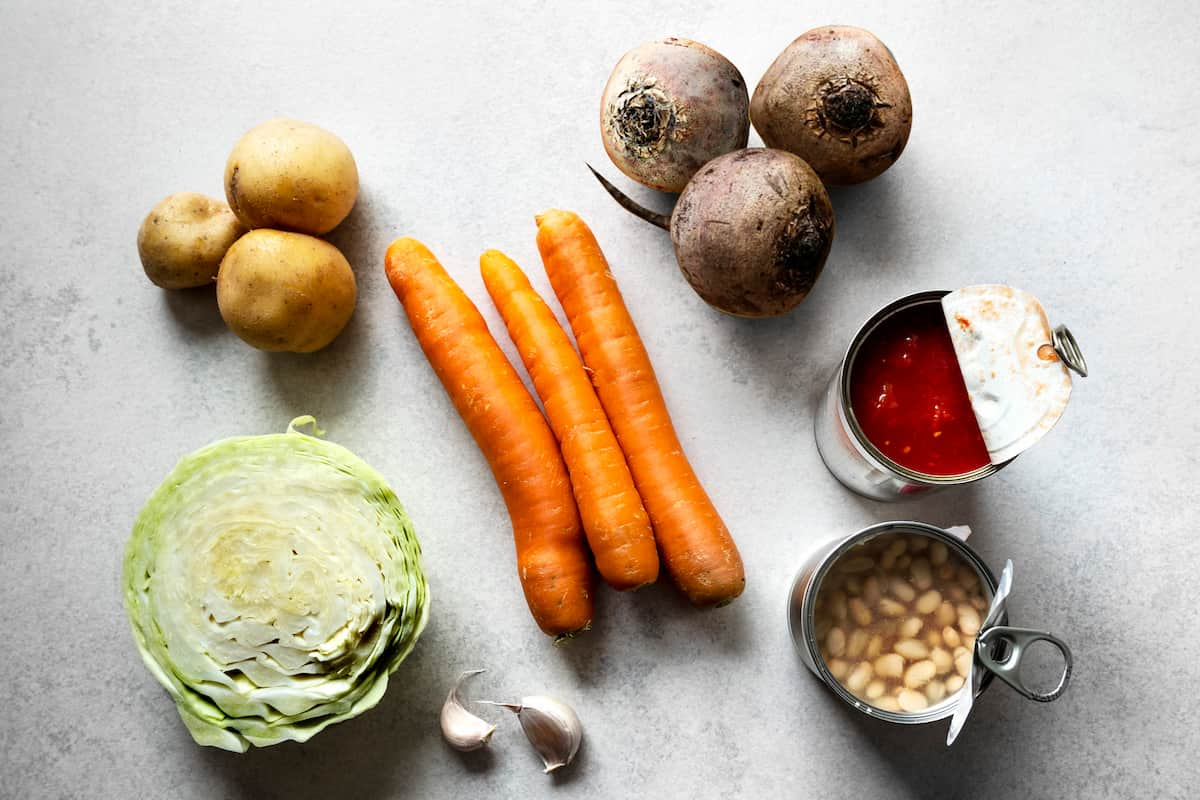
Equipment-wise, you’ll need:
- Larger cooking pot (stock pot) with a lid – 4 quarts (4 litres) or above.
- Smaller cooking pot, for potatoes.
- Small frying pan/skillet
- Fine mesh sieve, for straining the broth
- Vinyl gloves, for peeling and slicing beetroots
It’s worth mentioning that this soup tastes best the next day. That’s why I usually double this recipe, so we can enjoy it for longer.
How to cook ‘Barszcz Ukraiński’?
Step 1
Cook the broth (on pork rib, celeriac, small leek and spices) until the meat softens (1-2 hours).
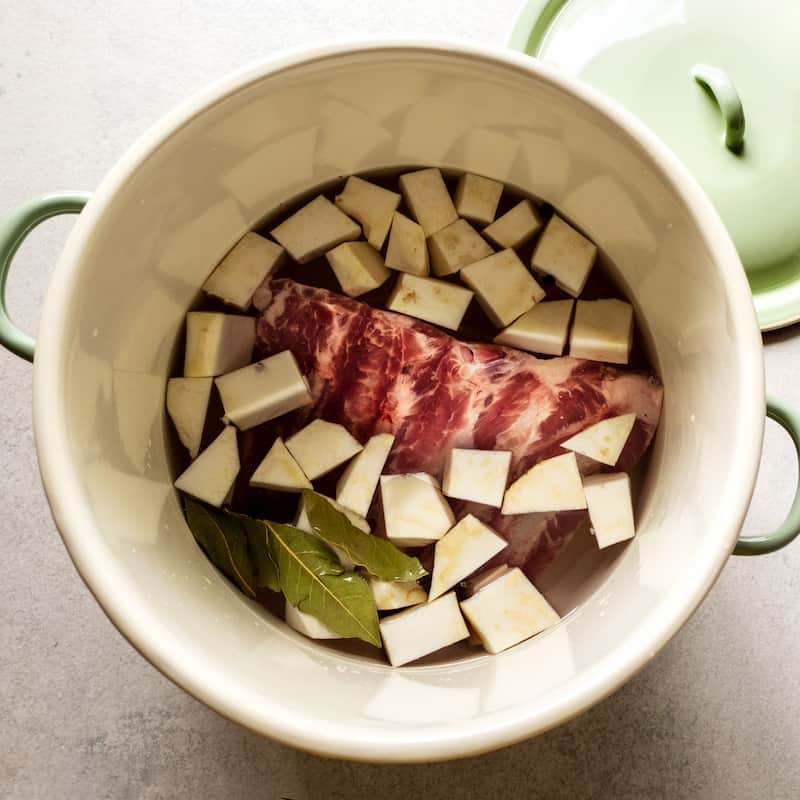
Step 2
Peel the potatoes, dice them into cubes. Cook for 15 minutes, until they’re nearly done. Set aside.

Step 3
Peel the carrots, slice them in rounds. Peel the beetroots, dice them into cubes. Cut the cabbage into thin strips.
Peel the onion, chop it finely. Fry until lightly golden. Add all veggies to the soup as per instructions in the recipe card.
Step 4
Near the end, season well and add in cooked potatoes. Add meat taken off from the ribs. Serve with chopped herbs and a dollop of sour cream.
What should you serve with ‘Barszcz Ukraiński’?
In Poland, Barszcz Ukraiński is usually enjoyed as a starter, before the main course.
When served as a single course, it’s often enriched with sour cream, fresh dill, and hard-boiled eggs. On the side, you may find a piece of fresh bread or a portion of boiled potatoes with pork cracklings.
In Ukraine, borscht is often served with Pampushky (in Ukrainian: пампушки, in Polish: pampuszki). They’re small yeast rolls made with wheat, rye, or buckwheat flour, and covered in a garlic dressing.
Can you make this Borscht another way?
Yes, you can:
- Cook a meat-free stock, skipping the ribs and adding more veggies, i.e. leeks, carrots, celery stalks…
- Cook the stock in a slow-cooker or instant pot (sorry, I cannot assist you with details, I don’t have much experience with these devices)
- Speed up the process by using a store-bought broth from a carton.
What diets is this Ukrainian-style Borscht suitable for?
This recipe is suitable for those who follow a gluten-free diet.
To make meat-free as well, use a vegetable broth/stock instead.
How long can you keep this ‘Barszcz Ukraiński’ in the fridge?
Once you’ve served the soup, ideally you should consume it within 3-4 hours. Don’t keep it out on a dinner table for longer periods.
If you allow any leftovers to cool, you can refrigerate them in a container with a lid. You can keep Barszcz Ukraiński in the fridge for approximately 4 days or so.
Can I freeze this BorScht?
You can, although please note that potatoes might change their texture a bit – sometimes they turn grainy.
To freeze, let the leftovers cool completely. Next, pour the soup into a freezer-friendly container. It’s worth using smaller containers and freeze each portion individually.
Label the container(s) with a description and a date. Aim to consume within 3 months.
How do I reheat this SOUP?
From chilled: Pour the soup into a microwavable container. Cover it with a loosely-fitted lid. Heat for 4 to 7 minutes until hot throughout. Stir before serving.
From frozen: Thaw the Barszcz overnight. Pour the soup into a microwavable container and reheat (covered) for 3 to 5 minutes. Carefully remove from the microwave and stir. Continue cooking for another 5 minutes, until hot throughout. Make sure to give it a stir before you serve.
You could also reheat the soup on the stove. Bring the soup to a boil, then reduce the heat and continue cooking for another 2-3 minutes (on medium-low).
Smacznego!
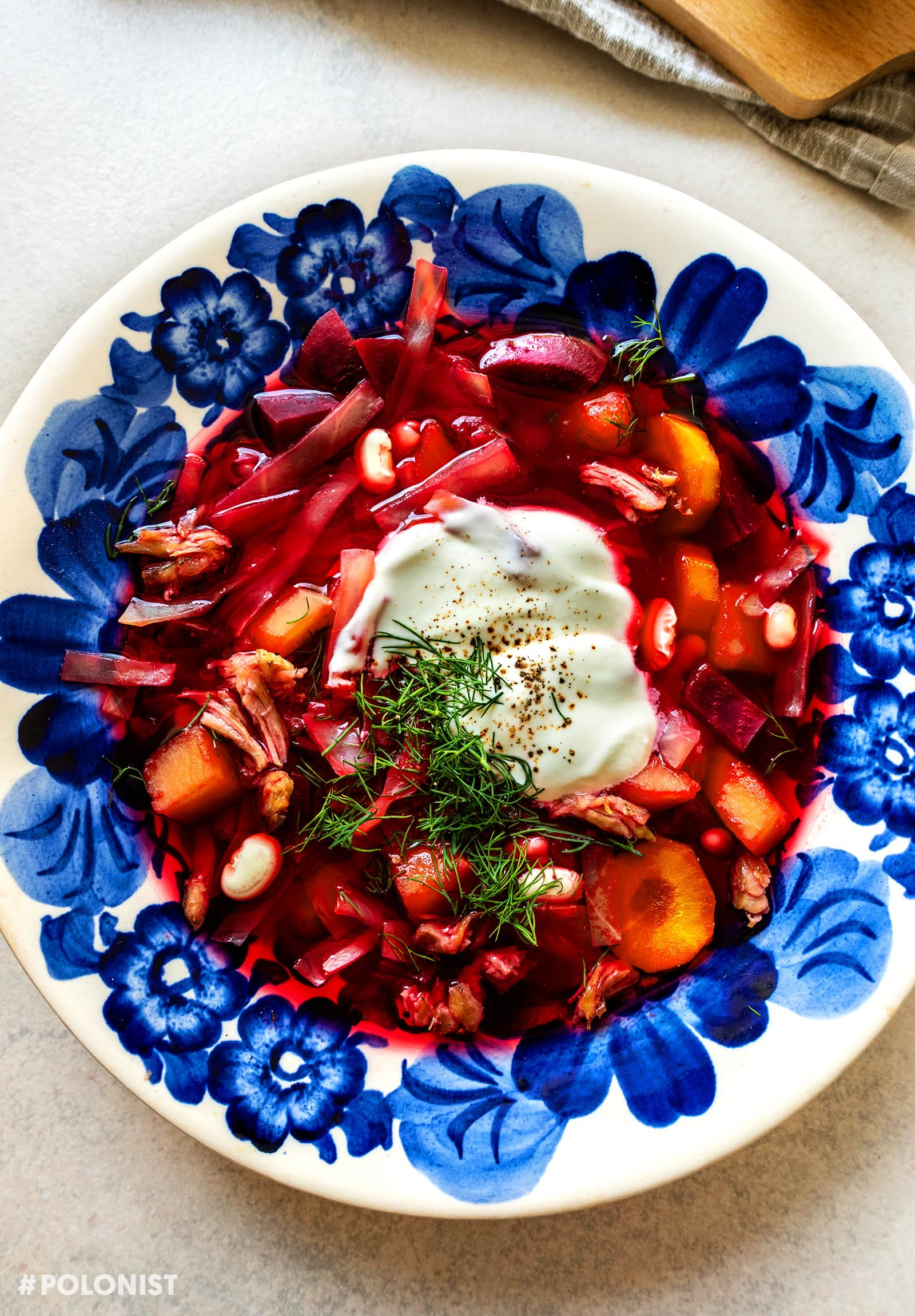
Barszcz Ukraiński: Borscht with White Beans (aka “Ukrainian Borscht”)
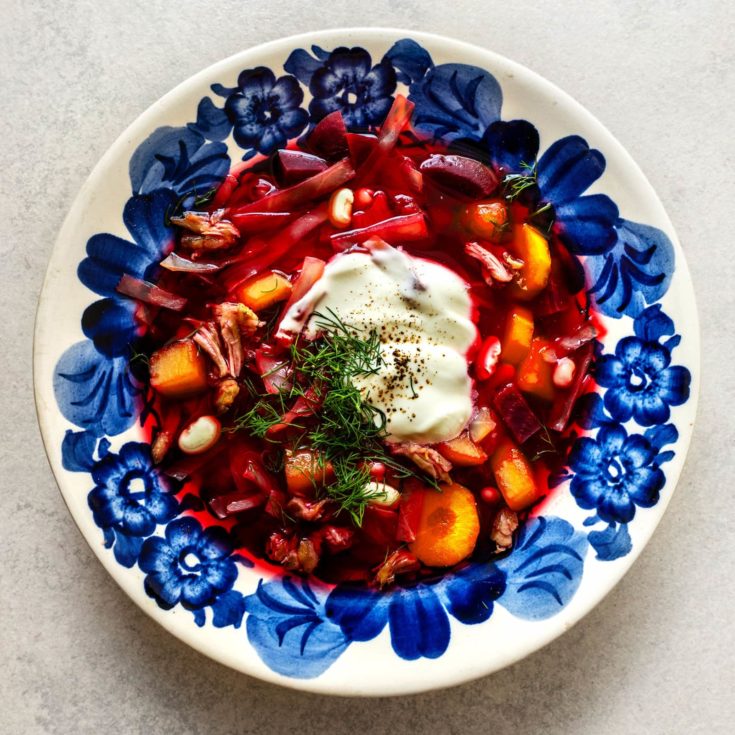
It’s definitely worth making a double batch. You’ll end up with a lot of soup, but:
- You’ll use up a full can of tomatoes, and a full can of white beans.
- It just tastes better the next day :)
Ingredients
For the Broth
- ½ small celeriac/celery root (approx. 9 oz, 250 g); can replace with a mix of onions and celery stalks
- 1 small leek, optional
- 1 pound (450-500 g) pork ribs
- 3-4 bay leaves
- 3-4 allspice berries
- 0.5 gallon (2 qt, just under 2 litres) water
- ½ tablespoon salt
For the Soup
- 0.5 lb (225-250 g) potatoes
- ½ teaspoon salt
- 3 red beetroots (approx. 12 oz, 340 g)
- 3 carrots (10 oz, 280 g)
- 0.5 lb (225-250 g) cabbage, white, green or savoy; that’s roughly a quarter of a big head
- 1 medium onion (approx. 4 oz, 110 g); white or yellow
- 1 tablespoon canola oil or clarified butter
- 2 garlic cloves
- ½ can tomatoes (approx. 7 oz, 200 g); peeled and diced
- ½ can Cannellini/White Kidney or Lima Beans, soaked
- 2 tablespoons apple cider vinegar, lemon juice, or beet kvass
- 1 teaspoon sugar
- pinch of black pepper, ground
For Serving
- 8 tablespoons fresh herbs (dill or parsley); chopped
- sour cream; for serving
Instructions
For the Broth:
- Prepare a large cooking pot, sized at 3 quarts (3 litres) or more.
- Peel the celery root and cut it into chunks. Add to pot.
- Chop the small leek into a few pieces. Add to pot.
- Divide the ribs into two or three pieces. Add to pot.
- Add bay leaves and allspice berries and cover with half a gallon (2 litres) of water. All the ingredients should be covered here, if not - add more water.
- Bring to boil, then reduce the heat. Cover with a lid.
- The cooking time will depend on your meat. It can take anywhere between 1 and 2 hours. My advice is to cook the meat for one hour, and then check on it every 15 minutes, “poking” with a fork. The meat should be soft and easily falling off the bone.
- In the meantime, you can start prepping the vegetables (skip to ‘For the potatoes’ and ‘Vegetable prep’ sections).
- Once the broth has cooked and the meat is soft, switch off the heat. Move the meat into a bowl and let it cool down.
- Strain the broth and get rid of all the remaining vegetables and herbs. Return to the pot. I usually salt the broth at this point (half a tablespoon).
Cooking Potatoes:
- I find it’s best to cook them separately, in order to keep their colour and flavour.
- Peel the potatoes, dice them into cubes (with 0.4’’/1 cm sides, or larger).
- Drop the potatoes into a smaller cooking pot, add salt and cover with water. Cover the pot with a lid and cook for 15 minutes. The aim is to get the potatoes ‘nearly done’
- Strain the potatoes and set them aside.
Vegetable prep:
- Put gloves on. Peel the beetroots and dice them into cubes (roughly with 0.4’’/1 cm sides). Set aside.
- Peel the carrots, slice them into rounds (roughly 0.2’’/0.5 cm thick). Set aside.
- Cut the cabbage into thin strips, set aside.
- Peel the onion, chop it finely. Using a small frying pan (skillet), heat up a drop of oil. Fry chopped onion on medium heat, until lightly golden. Set aside.
For the Soup:
- Once the broth is cooked and strained, we can start adding the vegetables.
- Add beetroots and carrots into the broth, cover with a lid and bring to boil. Reduce the heat and cook on medium heat for 15 minutes.
- As the soup cooks, take the meat off the bones. Discard the bones and set the meat aside.
- Once 15 minutes are up, add in the cabbage, tomatoes (with their juices) and white beans (without their brine).
- Peel two garlic cloves and slice them finely, add to the pot.
- Bring the soup to a near-boil. Cover the pot, reduce the heat and cook for 10 minutes.
- Once 10 minutes are up, add 2 tablespoons of vinegar (I use beet kvass instead) and a teaspoon of sugar.
- To finish off, add in the meat, browned onion and pre-boiled potatoes. Season with ground pepper. Stir well and have a taste. Does it need more seasoning? Or more acidity? If so, season the soup a bit more.
- Cook the soup for another 5 minutes, let the flavours combine.
- Serve hot, with a generous sprinkle of chopped herbs and a dollop of sour cream.
Notes
- The recipe is loosely adapted from:
the recipe by chef Karol Okrasa (who uses duck meat), and... - Marek Łebkowski's cookbook "Kuchnia Polska. Dania na każdą okazję" ("Polish Cuisine. Meals for every occasion."), published in 1997 by Reader's Digest, ISBN 9788360123041.
Nutrition Information:
Yield:
6Serving Size:
1Amount Per Serving: Calories: 209Total Fat: 7gSaturated Fat: 2gTrans Fat: 0gUnsaturated Fat: 4gCholesterol: 13mgSodium: 799mgCarbohydrates: 30gFiber: 8gSugar: 9gProtein: 9g
Polonist is reader-supported. When you buy through links on our site, we may earn a small affiliate commission. Learn more
Recipe Information
Filed under:
Alternative traditional/regional names:
Zupa Buraczkowa, Barszcz Czerwony, Barszcz Czernichowski, Barszcz z Fasolą
Also known / Misspelt internationally as:
Borscht à la Ukraine, Ukrainian Borscht, Chernihiv Borscht
Tested by:
First published on:
Recipe by / Adapted from:
Story by:
Bibliography / References:
